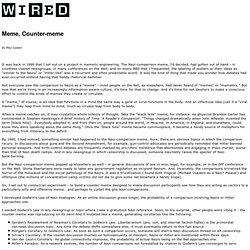

15752/1/15752.pdf. Three Challenges for the Survival of Memetics. Edmonds, B. (2002).

Three Challenges for the Survival of Memetics. Journal of Memetics - Evolutionary Models of Information Transmission, 6. In my opinion, memetics has reached a crunch point. If, in the near future, it does not demonstrate that it can be more than merely a conceptual framework, it will be selected out. While it is true that many successful paradigms started out as such a framework and later moved on to become pivotal theories, it also true that many more have simply faded away.
Such frameworks have considerable power over those that hold them for these people will see the world through these `theoretical spectacles' (Kuhn 1969) - to the converted the framework appears necessary. For this reason I am challenging the memetic community of academics to achieve the following three tasks of different types: a conclusive case-study; a theory for when memetic models are appropriate; and a simulation of the emergence of a memetic process.
Nursery rhymes. Mutation, Selection, and Vertical Transmission of Theistic Memes in Religious Canons. Gottsch, J.

D. (2001). Mutation, Selection, and Vertical Transmission of Theistic Memes in Religious Canons.Journal of Memetics - Evolutionary Models of Information Transmission, 5. Abstract 1 - Introduction 2 - First Evidence of Memes 3 - First Theistic Memes in Religious Canons 3.1 - Epic of Gilgamesh 3.2 - Enuma elish 3.3 - Law Codes 4 - Theistic Memetic Creation of the Hebrew Canon 5 - Theistic Memetic Mutation in Creation of the Christian Canon 6 - Theistic Memetic Mutation in Creation of the Islamic Canon 7 - Discussion References Abstract A study of ancient and modern Near Eastern religious canons reveals the mutation, selection, and vertical transmission of fitness-enhancing textual units, defined as theistic memes. Dawkins (1976) coined the term meme (from the Greek mimeme, meaning "imitation") to describe a unit of cultural transmission.
Memes that convey dictated social behavior can be categorized as either secular or theistic. Susan Blackmore on memes and "temes" A Note on the Origin of Memes/Mnemes. Laurent, J. (1999).

A Note on the Origin of Memes/Mnemes.Journal of Memetics - Evolutionary Models of Information Transmission,3. In the Selfish Gene Richard Dawkins says that he had originated the term `meme', a cultural equivalent of `gene', by shortening `mimeme' which he says he derived from the Greek mimeisthai, to imitate. This may be, but another, and more straightforward source for the term, I would suggest, is `mneme', referring to a unit of memory and taken from the Greek mimneskesthai, to remember (and ultimately from Mnemosyne, the Greek goddess of memory [Note 1]), and which appears in the book The Soul of the White Ant, by the Belgian dramatist, essayist and amateur entomologist, Maurice Maeterlinck, first published in 1927. Dawkins writes as follows: "DNA is a self-replicating piece of hardware. 1.
Dawkins, R. (1989). Maeterlinck, M. (1927). Journal of Memetics - Evolutionary Models of Information Transmission. Meme, Counter-meme. Meme, Counter-meme By Mike Godwin It was back in 1990 that I set out on a project in memetic engineering.

The Nazi-comparison meme, I'd decided, had gotten out of hand - in countless Usenet newsgroups, in many conferences on the Well, and on every BBS that I frequented, the labeling of posters or their ideas as "similar to the Nazis" or "Hitler-like" was a recurrent and often predictable event. It was the kind of thing that made you wonder how debates had ever occurred without having that handy rhetorical hammer. Varieties of meaning: the 2002 Jean ... Meme. A meme (/ˈmiːm/ meem)[1] is "an idea, behavior, or style that spreads from person to person within a culture.

"[2] A meme acts as a unit for carrying cultural ideas, symbols, or practices that can be transmitted from one mind to another through writing, speech, gestures, rituals, or other imitable phenomena with a mimicked theme. Supporters of the concept regard memes as cultural analogues to genes in that they self-replicate, mutate, and respond to selective pressures.[3] The word meme is a shortening (modeled on gene) of mimeme (from Ancient Greek μίμημα Greek pronunciation: [míːmɛːma] mīmēma, "imitated thing", from μιμεῖσθαι mimeisthai, "to imitate", from μῖμος mimos "mime")[4] and it was coined by the British evolutionary biologist Richard Dawkins in The Selfish Gene (1976)[1][5] as a concept for discussion of evolutionary principles in explaining the spread of ideas and cultural phenomena.
Dawkins' own position is somewhat ambiguous: he obviously welcomed N. History[edit] Culture & Meme. Meme-Gene Coevolution.